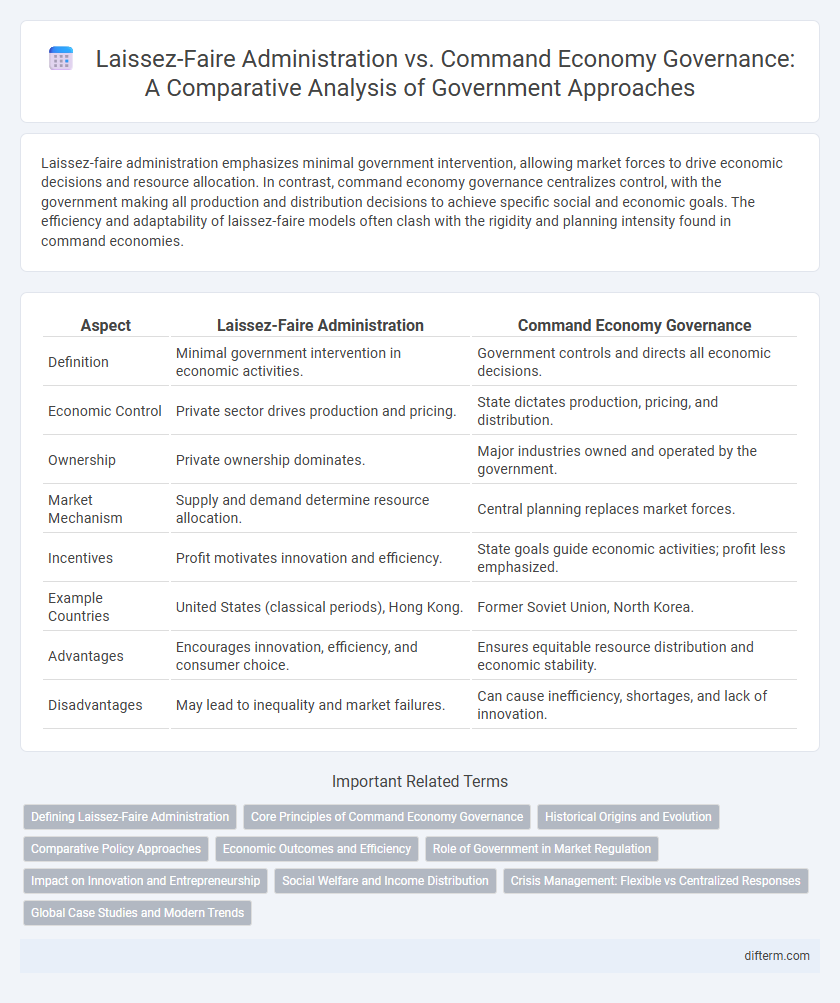Laissez-faire administration emphasizes minimal government intervention, allowing market forces to drive economic decisions and resource allocation. In contrast, command economy governance centralizes control, with the government making all production and distribution decisions to achieve specific social and economic goals. The efficiency and adaptability of laissez-faire models often clash with the rigidity and planning intensity found in command economies.
Table of Comparison
| Aspect | Laissez-Faire Administration | Command Economy Governance |
|---|---|---|
| Definition | Minimal government intervention in economic activities. | Government controls and directs all economic decisions. |
| Economic Control | Private sector drives production and pricing. | State dictates production, pricing, and distribution. |
| Ownership | Private ownership dominates. | Major industries owned and operated by the government. |
| Market Mechanism | Supply and demand determine resource allocation. | Central planning replaces market forces. |
| Incentives | Profit motivates innovation and efficiency. | State goals guide economic activities; profit less emphasized. |
| Example Countries | United States (classical periods), Hong Kong. | Former Soviet Union, North Korea. |
| Advantages | Encourages innovation, efficiency, and consumer choice. | Ensures equitable resource distribution and economic stability. |
| Disadvantages | May lead to inequality and market failures. | Can cause inefficiency, shortages, and lack of innovation. |
Defining Laissez-Faire Administration
Laissez-faire administration refers to a governance approach where government intervention in the economy is minimal, allowing market forces of supply and demand to operate freely. This system prioritizes private enterprise autonomy, limited regulations, and reduced public sector control over production and distribution. Compared to command economy governance, laissez-faire administration trusts decentralized decision-making to drive economic efficiency and innovation.
Core Principles of Command Economy Governance
Command economy governance is defined by centralized control where the government dictates production, distribution, and pricing of goods and services. Core principles include state ownership of resources, central planning by government agencies, and the elimination of private enterprise to ensure equal resource allocation and social welfare. This system emphasizes regulatory frameworks that enforce compliance, aiming to achieve economic goals through coordinated planning rather than market-driven forces.
Historical Origins and Evolution
Laissez-faire administration traces its origins to 18th-century classical economics, emphasizing minimal government interference in markets to foster individual entrepreneurship and free trade. Command economy governance evolved from early 20th-century socialist and communist ideologies, notably implemented in the Soviet Union, focusing on centralized planning and state ownership of resources. Historical shifts such as the Industrial Revolution and Cold War tensions propelled the evolution of these contrasting governance models, shaping modern economic policies worldwide.
Comparative Policy Approaches
Laissez-faire administration emphasizes minimal government intervention, promoting economic freedom and individual entrepreneurship, while command economy governance relies on centralized planning and control over resources and production to achieve policy objectives. Comparative policy approaches reveal that laissez-faire systems tend to foster innovation and market efficiency but may lead to inequality and market failures, whereas command economies prioritize equitable resource distribution and social welfare at the cost of reduced economic incentives and potential inefficiencies. These contrasting frameworks reflect differing governmental roles in economic regulation and societal development, shaping policy outcomes across diverse political and economic contexts.
Economic Outcomes and Efficiency
Laissez-faire administration promotes economic efficiency through minimal government intervention, allowing market forces to allocate resources and drive innovation, resulting in higher productivity and consumer choice. In contrast, command economy governance centralizes decision-making, often leading to resource misallocation, inefficiencies, and slower economic growth due to lack of competition and bureaucratic delays. Empirical data shows that market-driven economies consistently outperform command economies in GDP growth rates and overall economic welfare.
Role of Government in Market Regulation
In a laissez-faire administration, government intervention in market regulation is minimal, allowing supply and demand to naturally determine prices and production, fostering economic freedom and innovation. Conversely, command economy governance involves extensive government control over resources, production, and pricing to achieve specific socio-economic objectives and reduce market uncertainties. The role of government in market regulation fundamentally contrasts between these models, with laissez-faire emphasizing limited oversight and command economies prioritizing centralized planning and regulation.
Impact on Innovation and Entrepreneurship
Laissez-faire administration fosters innovation and entrepreneurship by minimizing government intervention, allowing market forces to drive creativity and business growth. In contrast, command economy governance often stifles innovation due to centralized planning and strict regulations that limit individual initiative and risk-taking. Empirical studies show that countries with laissez-faire policies tend to have higher rates of startup formation and technological advancement compared to command economies.
Social Welfare and Income Distribution
Laissez-faire administration emphasizes minimal government intervention, allowing market forces to dictate social welfare and income distribution, often resulting in significant income disparities and limited social safety nets. In contrast, command economy governance involves centralized planning to directly allocate resources and ensure equitable social welfare programs, aiming to reduce income inequality through state-controlled redistribution mechanisms. The effectiveness of social welfare and income distribution depends on the balance between market freedom and governmental control within these economic frameworks.
Crisis Management: Flexible vs Centralized Responses
Laissez-faire administration in crisis management prioritizes flexible, decentralized responses, empowering local entities and private sectors to adapt swiftly to emerging challenges. In contrast, command economy governance employs centralized decision-making and resource allocation, enabling coordinated and uniform crisis interventions under direct government control. The effectiveness of each system depends on the nature of the crisis and the need for rapid innovation versus consistent policy enforcement.
Global Case Studies and Modern Trends
Laissez-faire administration in global contexts, exemplified by Hong Kong's minimal regulatory intervention, contrasts sharply with command economy governance seen in North Korea's state-controlled resource allocation and production. Modern trends reveal hybrid models like China's mixed economy, combining centralized planning with market-driven mechanisms to balance efficiency and control. Comparative analyses of these governance frameworks indicate varying impacts on economic growth, innovation, and social welfare depending on the degree of state intervention.
Laissez-Faire Administration vs Command Economy Governance Infographic

 difterm.com
difterm.com